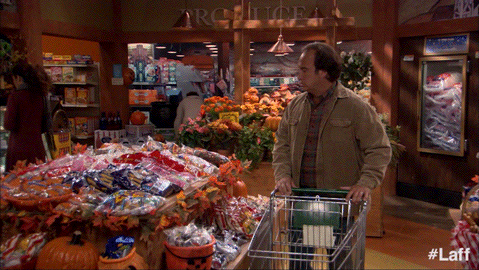Viking Bread
Posted: September 6, 2019 Filed under: Bread | Tags: bread, easy, granary, seeds, vegan, vegetarian 13 Comments
Wotchers!
I’ve taken a bit of a liberty with the name of this recipe, because it’s based on nothing more authentic than the loaf of bread I tried in France this summer. Over there, it is a staple of the Banette brand of bakeries and I found it very delicious as well as belying it’s rustic appearance by being very light in texture.
I picked up an information leaflet about it which helpfully included, amongst a lot of airy-fairyness about taste journeys and Nordic inspiration, a list of ingredients:
- wheat flour
- wheat gluten
- sunflower seeds
- barley flour
- rye products
- toasted malted barley flour
- rye and wheat malt
- yeast
- salt
- Decorations:
- barley flakes
- sunflower seeds
- decorticated sesame seeds
- red millet seeds
- brown flax seeds
Fantastic, you’d think – specific guidelines for creating a unique blend of flours, grains and seeds. Well, in theory, yes – but practically… not so much. For a while I toyed with the idea of sourcing toasted malted barley flour, rye and wheat malt, and then experimenting with numerous batches to achieve the perfect combination. But when I read the ingredients list on a pack of Granary bread flour, it was a no-brainer.

Me choosing between the task of creating a sword-wielding, nuanced and balanced mix of flours and grains vs grabbing a packet of granary bread flour.
Then there was the mix of seeds. Again, I could have spend time researching and experimenting, and to a certain extent I did. Recently, whilst watching Italian chefs make pizza dough, one of them mentioned adding Cuor di Cereali (Heart of Cereal), a seed mixture available in Italy, which sounded perfect. I sourced it online, however, it is available only in Italy, and whilst it could be ordered internationally, the shipping was going to be a killer. So when I saw the range of seeds available in the supermarket, I was like…

Me in the supermarket, carefully making a selection of seeds.
I did, however, take the suggestion from the Mulino Caputo website of adding between 10-20% to your dough mix, so it wasn’t a total bust.
Seed Mix
This is absolutely customisable to what you have available. I make no apology for simply tipping into a large ziplock bag one packet of each of the seeds available at my local supermarket.
My mix comprised the following:
- 100g golden linseed
- 100g brown linseed
- 100g sunflower seeds
- 100g pumpkin seeds
- 150g chia seeds
- 100g sesame seeds
- 100g poppy seeds
This obviously makes more than is required for the recipe, but I’m confident you’ll be using it all up in no time with batches of these tasty loaves.
Viking Bread
400ml tepid water
1 tsp salt
500g granary bread flour
20g fresh yeast, crumbled or 1 sachet fast-action yeast
100g seed mix
additional seed mix for coating
- Put all of the ingredients into your bowl (hand or stand mixer) in the above order, and bring together into a soft dough.
- Knead for 10 minutes – on Low, if you’re using a mixer, followed by 2 minutes on High.
- Cover the bowl with plastic and leave to rise for 1 hour.
- When risen, tip out onto a floured surface and pat gently to deflate.
- Shape into a rectangle, and cut horizontally in two,to give two baton shapes.
- Roll and tuck the edges underneath – you should be aiming for a short, fat baguette shape.
- Take an edged baking sheet and sprinkle over a layer of the seed mix. If you slide the sheet back and forth a couple of times,the seeds will arrange themselves in a neat, thin layer.
- Using a pastry brush dipped in water, dampen the whole of the upper surface of the loaves.
- Apply the seed coating: one by one, picking up the loaves and roll them over the layer of seeds in the tray. The seeds will stick to the damp top surface of the dough and fall away from the dry underside. Set the seeded loaves on their uncoated bases on a baking sheet lined with parchment. Cover lightly and leave to rise for 30 minutes.
- Heat the oven to 200°C, 180°C Fan.
- Bake the loaves for 30-35 minutes until risen and browned, and the base sounds hollow when tapped.
- Cool on a wire rack.
Killer gif usage! This looks really delicious.
Wotchers martina!
Glad you liked the gifs – more comedy in cooking is what I say!
MAB 😀
It looks and sounds delicious! Have to try 😮
Wotchers julyvee94!
Spoiler alert – it is!
Which is why you need two loaves, as the first diappears with alarming speed 😉
MAB 😀
Hello Maryann!
Greeting from an Australian currently in Malta.
As Netflix has released Great BB Off from the begining, you have come to my attention only recently. In the final notes of series 2 it was mentioned you were starting a cooking blog. I am so pleased to see you are still producing this fun and informative blog!
Recipes here are great! Cant wait to get to a proper kitchen and try some out!
Cheers,
Liz
Wotchers Liz!
Finally – you’re here! We’ve been waiting AGES!!
Come on in and join the fun – Spoiler alert: there’s CAKE! 😉
MAB 😀
Hello! I recently discovered Viking bread in Paris and would like to bake it myself – at home in Maryland, usa. Your recipe uses granary bread flour which contains malted wheat flakes and malted barley flour. in my country those two products are only available online but I’ll have to get some and make my own granary mix.. Thanks for your information and recipe.
Marjorie
Last week I bought Viking Bread (baguette) at La Parisienne Boulangerie on Boulevard Saint-Germaine in the Latin Quarter, Paris. https://www.yelp.com/biz/la-parisienne-paris-5
Do you have any updates on recipes for this bread?
Thanks,
Marjorie
Wotchers Marjorie!
No updates this end, I’m afraid. What were you looking for, specifically?
MAB 😀
In your Viking Bread recipe you use granary bread flour. We don’t have that in the U.S. so I wonder if you could suggest a substitution.
Thanks,
Marjorie
I can certainly give you a suggestion or two, Marjorie!
The King Arthur Baking Company sells two ingredients you might like to try: Malted Wheat Flakes and Six Grain Blend.
I would suggest the following proportions: 2 cups wholemeal bread flour, 2 cups white bread flour and 1 cup of either of the above ingredients.
Some brands in the UK include a little (1/4 or 1/3 cup) rye in their mix, and sometimes malt flour (1tbs as it is quite strong).
Together with the seed mix, I’d suggest you could just use the malted Wheat Flakes to begin with, and then see how you like the result. You can always add to it if you feel it lacks a little something.
Hope this helps!
MAB 😀
I ordered the 6 – Grain Blend from King Arthur and made some great bread today. https://brwbmm.wordpress.com/2024/06/10/6-grain-bread/
I wonder how the French bakeries make such dark brown breads. I know that pumpernickel breads use a combination of molasses, coffee and cocoa to get a brown color but these ingredients give breads a softer, cakier texture instead of the desired chewy texture.
Marjorie
[…] © Time To Cook – Online […]